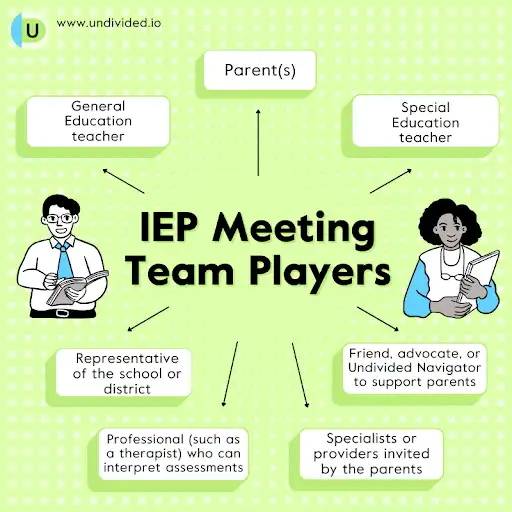Collaboration with Key Stakeholders
IEP Team Stakeholders
Effective transition planning requires collaboration among several key stakeholders to ensure students with disabilities receive the support they need for life after high school.

- Student: The most important participant, as transition planning should be centered around their strengths, interests, goals, and aspirations.
- Parents/Guardians: Provide insight into the student’s needs, advocate for services, and help with long-term planning.
- Special Education Providers: Develop and implement transition-related goals within the IEP, ensuring alignment with academic and vocational plans.
- General Education Teachers: Support skill development in academic settings and provide insight into the student’s progress in general education courses.
- School Counselors: Help explore postsecondary education options, career pathways, and coordinate necessary supports.
- Transition Specialists or Coordinators: Facilitate transition services, connect students to community resources, and ensure compliance with legal requirements.
- Vocational Rehabilitation Counselors (e.g., Department of Rehabilitation Representatives): Assist with employment training, job placement, and access to vocational rehabilitation services.
- Community Agencies (e.g., Regional Centers, Workforce Innovation and Opportunity Act (WIOA) programs): Provide additional support in areas like independent living, employment, and adult services.
- Postsecondary Representatives (e.g., Disability Services from colleges or training programs): Ensure students understand and access accommodations and supports in higher education settings.
- Employers and Career/Job Training Program Representatives: Offer job training, work experience, and employment opportunities for students exploring career options.
By involving a comprehensive team of stakeholders, transition planning becomes more effective in preparing students with disabilities for successful futures in education, employment, and independent living.
Community Agencies
Coordinating with various community agencies, service providers, employers, and post-secondary institutions is essential to ensure a smooth transition for students. This involves collaboration with vocational rehabilitation agencies, disability service organizations, and other community resources to provide additional support and resources as needed.
Regional Center:
- In California, Regional Centers are nonprofit organizations designated by the state to provide lifelong services and supports to individuals with developmental disabilities and their families.
- There are 21 Regional Centers throughout the state, each serving a specific geographic area.
- They offer a wide range of services tailored to the unique needs of individuals with developmental disabilities, including intellectual disabilities, cerebral palsy, autism, epilepsy, and other related conditions.
- For more information, see Department of Developmental Services, Regional Centers.
Department of Rehabilitation (DOR):
- The DOR in California is a state agency dedicated to providing vocational rehabilitation services and employment support to individuals with disabilities.
- Its mission is to empower Californians with disabilities to achieve competitive employment, independence, and inclusion in the workforce and community.
- The DOR offers various services to assist individuals with disabilities in preparing for, obtaining, and maintaining employment.
- For more information, see California Department of Rehabilitation.
By working together with these and other agencies, students with extensive support needs can access the resources and support necessary for a successful transition to adulthood.
Community Partnerships
Establishing strong partnerships between schools, families, and community organizations is crucial for supporting students, offering benefits that are difficult to quantify. Collaboration is a key element of a successful special education program, particularly for students requiring support from multiple agencies. Students often need a comprehensive network of support that spans education, healthcare, and social services. By working collaboratively with agencies such as Regional Centers, Departments of Rehabilitation, Children’s Services, SELPA, and local Family Empowerment Centers (FECs), educators can gain a deeper understanding of each child’s strengths and needs. This collaborative approach aids in the development of a robust Individualized Education Program (IEP), maximizing the benefits to students. Collaboration with community partners and relevant agencies is particularly crucial. Students may require specialized services and resources to address needs effectively. By fostering collaboration with healthcare providers, social services, and community organizations, educators can ensure comprehensive support for students and their families. Establishing strong relationships with these partners enables the coordination of services and resources, resulting in a more cohesive and holistic approach to supporting students with extensive needs.
Prioritizing communication and collaboration are essential for addressing students' diverse needs and promoting their overall well-being and success. By working together as a team, educators and community partners can better identify and address barriers to learning, access, and participation for students with extensive support needs. This collaborative approach not only enhances the effectiveness of special education programs but also fosters a supportive and inclusive environment where all students can thrive and reach their full potential.
